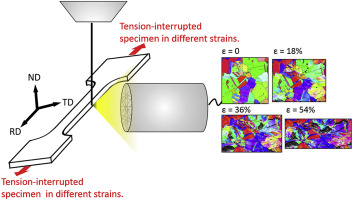当前位置:
X-MOL 学术
›
Intermetallics
›
论文详情
Our official English website, www.x-mol.net, welcomes your
feedback! (Note: you will need to create a separate account there.)
Differences in texture evolution from low-entropy to high-entropy face-centered cubic alloys during tension test
Intermetallics ( IF 4.3 ) Pub Date : 2020-03-01 , DOI: 10.1016/j.intermet.2019.106635 Kuan-Hao Lin , Shou-Yi Chang , Yu-Chieh Lo , Chun-Chieh Wang , Su-Jien Lin , Jien-Wei Yeh
Intermetallics ( IF 4.3 ) Pub Date : 2020-03-01 , DOI: 10.1016/j.intermet.2019.106635 Kuan-Hao Lin , Shou-Yi Chang , Yu-Chieh Lo , Chun-Chieh Wang , Su-Jien Lin , Jien-Wei Yeh

|
Abstract Texture evolution during tension test was investigated on three face-centered cubic (FCC) metals, namely, Ni (unary), equiatomic CrFeNi (ternary), and equiatomic CoCrFeMnNi (quinary) with small and large grain sizes of ~20 and ~100 μm, respectively. The microtextures for 18%, 36% and 54% engineering strains of a tension-interrupted specimen were characterized on the same area. The three metals exhibited a similar texture evolution, which the fraction of {001}//ND remains constant. However, the fraction of {011}//ND decreases, whereas that of {111}//ND increases. On the other hand, the fraction of //RD also remains constant, that of //RD decreases, and that of //RD increases. However, the several differences still were found during plastic deformation. Fine-grained Ni initiated a significantly crystallographic rotation (CRo) at the lower strain, increased with strain and then remained nearly unchanged as strain was higher than 18%. Coarse-grained Ni delayed this rotation and slowly developed the trend at large strains. As for CrFeNi, the comparison between fine-grained and coarse-grained structure does not have obvious difference. As for fine-grained CoCrFeMnNi, it can be seen that an obvious CRo develops under 36% strain, and maintains constant over 36% strain. But the coarse-grained CoCrFeMnNi reveals that the significant CRo develops continuously from 0% to 54% strain. The mechanisms for the effects of number of element and grain size in the present study are elucidated.
中文翻译:

拉伸试验过程中从低熵到高熵面心立方合金织构演变的差异
摘要 研究了三种面心立方 (FCC) 金属,即 Ni(一元)、等原子 CrFeNi(三元)和等原子 CoCrFeMnNi(五元),具有~20 和~100 的小晶粒和大晶粒尺寸的织构演变。微米,分别。拉伸中断试样的 18%、36% 和 54% 工程应变的微观纹理在同一区域进行表征。这三种金属表现出相似的织构演变,其中 {001}//ND 的分数保持不变。然而,{011}//ND 的部分减少,而 {111}//ND 的部分增加。另一方面,//RD的分数也保持不变,//RD的分数减少,而//RD的分数增加。然而,在塑性变形过程中仍然发现了一些差异。细粒镍在较低应变下引发显着的晶体旋转 (CRo),随应变增加,然后在应变高于 18% 时几乎保持不变。粗粒镍延迟了这种旋转,并在大应变下缓慢发展。对于CrFeNi,细晶组织和粗晶组织的比较没有明显差异。对于细晶粒的 CoCrFeMnNi,可以看出在 36% 应变下形成明显的 CRo,并在 36% 应变下保持恒定。但是粗晶粒的 CoCrFeMnNi 表明显着的 CRo 从 0% 到 54% 应变连续发展。阐明了本研究中元素数量和晶粒尺寸的影响机制。粗粒镍延迟了这种旋转,并在大应变下缓慢发展。对于CrFeNi,细晶组织和粗晶组织的比较没有明显差异。对于细晶粒的 CoCrFeMnNi,可以看出在 36% 应变下形成明显的 CRo,并在 36% 应变下保持恒定。但是粗晶粒的 CoCrFeMnNi 表明显着的 CRo 从 0% 到 54% 应变连续发展。阐明了本研究中元素数量和晶粒尺寸的影响机制。粗粒镍延迟了这种旋转,并在大应变下缓慢发展。对于CrFeNi,细晶组织和粗晶组织的比较没有明显差异。对于细晶粒的 CoCrFeMnNi,可以看出在 36% 应变下形成明显的 CRo,并在 36% 应变下保持恒定。但是粗晶粒的 CoCrFeMnNi 表明显着的 CRo 从 0% 到 54% 应变连续发展。阐明了本研究中元素数量和晶粒尺寸的影响机制。但是粗晶粒的 CoCrFeMnNi 表明显着的 CRo 从 0% 到 54% 应变连续发展。阐明了本研究中元素数量和晶粒尺寸的影响机制。但是粗晶粒的 CoCrFeMnNi 表明显着的 CRo 从 0% 到 54% 应变连续发展。阐明了本研究中元素数量和晶粒尺寸的影响机制。
更新日期:2020-03-01
中文翻译:

拉伸试验过程中从低熵到高熵面心立方合金织构演变的差异
摘要 研究了三种面心立方 (FCC) 金属,即 Ni(一元)、等原子 CrFeNi(三元)和等原子 CoCrFeMnNi(五元),具有~20 和~100 的小晶粒和大晶粒尺寸的织构演变。微米,分别。拉伸中断试样的 18%、36% 和 54% 工程应变的微观纹理在同一区域进行表征。这三种金属表现出相似的织构演变,其中 {001}//ND 的分数保持不变。然而,{011}//ND 的部分减少,而 {111}//ND 的部分增加。另一方面,//RD的分数也保持不变,//RD的分数减少,而//RD的分数增加。然而,在塑性变形过程中仍然发现了一些差异。细粒镍在较低应变下引发显着的晶体旋转 (CRo),随应变增加,然后在应变高于 18% 时几乎保持不变。粗粒镍延迟了这种旋转,并在大应变下缓慢发展。对于CrFeNi,细晶组织和粗晶组织的比较没有明显差异。对于细晶粒的 CoCrFeMnNi,可以看出在 36% 应变下形成明显的 CRo,并在 36% 应变下保持恒定。但是粗晶粒的 CoCrFeMnNi 表明显着的 CRo 从 0% 到 54% 应变连续发展。阐明了本研究中元素数量和晶粒尺寸的影响机制。粗粒镍延迟了这种旋转,并在大应变下缓慢发展。对于CrFeNi,细晶组织和粗晶组织的比较没有明显差异。对于细晶粒的 CoCrFeMnNi,可以看出在 36% 应变下形成明显的 CRo,并在 36% 应变下保持恒定。但是粗晶粒的 CoCrFeMnNi 表明显着的 CRo 从 0% 到 54% 应变连续发展。阐明了本研究中元素数量和晶粒尺寸的影响机制。粗粒镍延迟了这种旋转,并在大应变下缓慢发展。对于CrFeNi,细晶组织和粗晶组织的比较没有明显差异。对于细晶粒的 CoCrFeMnNi,可以看出在 36% 应变下形成明显的 CRo,并在 36% 应变下保持恒定。但是粗晶粒的 CoCrFeMnNi 表明显着的 CRo 从 0% 到 54% 应变连续发展。阐明了本研究中元素数量和晶粒尺寸的影响机制。但是粗晶粒的 CoCrFeMnNi 表明显着的 CRo 从 0% 到 54% 应变连续发展。阐明了本研究中元素数量和晶粒尺寸的影响机制。但是粗晶粒的 CoCrFeMnNi 表明显着的 CRo 从 0% 到 54% 应变连续发展。阐明了本研究中元素数量和晶粒尺寸的影响机制。











































 京公网安备 11010802027423号
京公网安备 11010802027423号